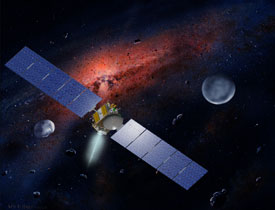
Among the many victims in the latest round of deep cuts was the Dawn asteroid rendezvous mission.
Orbital Sciences Corporation, William K. Hartmann, and UCLA
NASA's astronomy program is in a state of crisis as a growing number of space missions are falling to the budgetary ax. Smaller programs are suffering most in the 2006 budget as funding is siphoned toward human spaceflight. Additional cancellations are projected in the 2007 budget partly to help finance the James Webb Space Telescope and Hubble Space Telescope cost overruns. The coup de grâce is a whopping 15 percent overall cut in 2009.
In January, NASA officials canceled the high-energy X-ray Nuclear Spectroscopic Telescope Array (NuStar) Explorer mission. On March 2nd NASA's new head of science, Mary Cleave, terminated the Dawn asteroid mission. That craft had only a few months of work left to go before becoming launch ready. Cleave's announcement about Dawn came shortly after she testified to a hostile Congressional panel about the cuts.
Congressional leaders challenged both the internal and external priorities affecting the budget. The science community questioned whether large, overbudget missions should be protected at the expense of losing both the research jobs needed to analyze the data and the small missions needed to round out a healthy science program.
It's very unusual for missions to be cancelled so close to launch. The Dawn termination apparently saves only $30 million out of a $370 million project, and Dawn's cost overrun was mostly due to the impact of previous delays imposed by NASA headquarters rather than technical issues. The NuStar cancellation might be the most troubling, however. Here was a mission that was approved, on budget, and without technical problems. Killing something in such good shape is pretty much unheard of and belies earlier statements by NASA administrator Mike Griffin that missions were only to be delayed rather than canceled.
Funds earmarked for managers and users of existing space observatories, like the infrared Spitzer Space Telescope, have also been cut by millions. This has raised further threats of layoffs and job shortages. This is even true for Hubble, where the influx of extra money in the 2007 budget to support the proposed servicing mission won't, by and large, be going toward astronomers' salaries.
The 2007 budget also axed the Terrestrial Planet Finder, delayed the SIM interferometry testbed, and slated the SOFIA airborne infrared observatory for almost-certain cancellation. SOFIA was in the final stages of construction. The Beyond Einstein series of high-energy missions, including Constellation-X and the Laser Interferometer Space Antenna (LISA), is being kept alive with only a trickle of funding. Even ground-based projects such as the long-planned Keck Interferometer outrigger telescopes have been sent to a premature grave.
Morale is plummeting in the US space science community as senior scientists see years of work evaporate with a stroke of the financial pen, and young astronomy PhDs are wondering whether a career in the field is even possible. How US astronomy will take shape in the coming months and years remains in question as the food fight over how to reslice the shrinking funding pie begins.
 0
0
Comments
You must be logged in to post a comment.